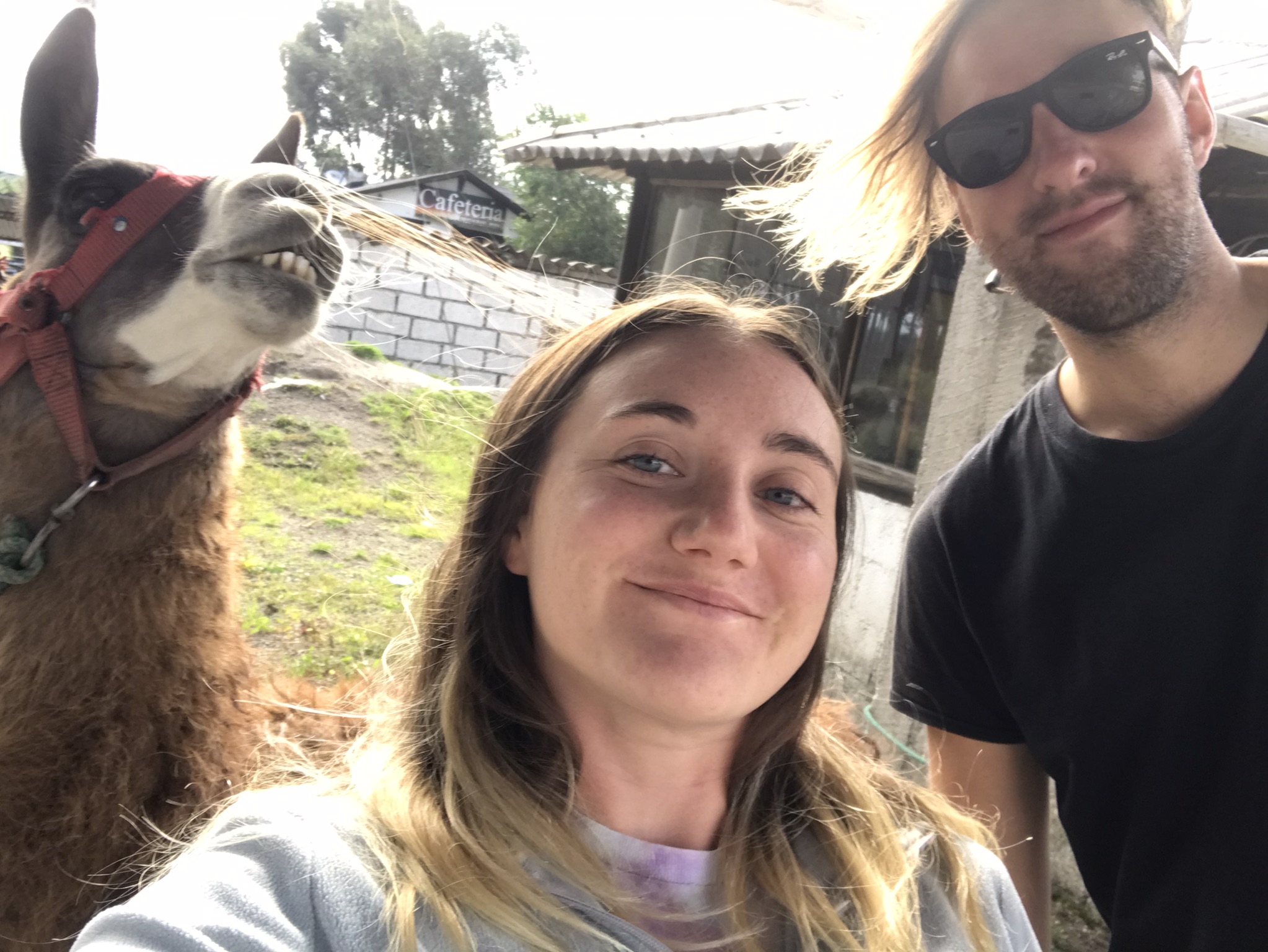Nestled in between Guatemala and Honduras, the small country of El Salvador was originally called just ‘Salvador’ until 1915, when the name was officially changed to El Salvador. Since then the country has had a tumultuous time, with a civil war in the 1980s and subsequent infestation by criminal gangs turning El Salvador into a battleground and one of the most dangerous countries in the world. El Salvador was considered a no-go area for most visitors up until very recently, but political developments post-Covid have led to a remarkable change and it has become one of the safest countries in Central America virtually overnight. While it also has beautiful landscapes, volcanoes and beaches, the recent social history and transformation of the country is still the prevailing factor in El Salvador. Outside visitors are still a novelty for the people of El Salvador and we had many positive interactions with locals who seemed genuinely excited and happy to see us, in contrast to the relative indifference of the locals in places with traditionally higher levels of tourism such as Mexico. Check out my El Salvador travel experiences below!
Santa Ana, Suchitoto, San Salvador
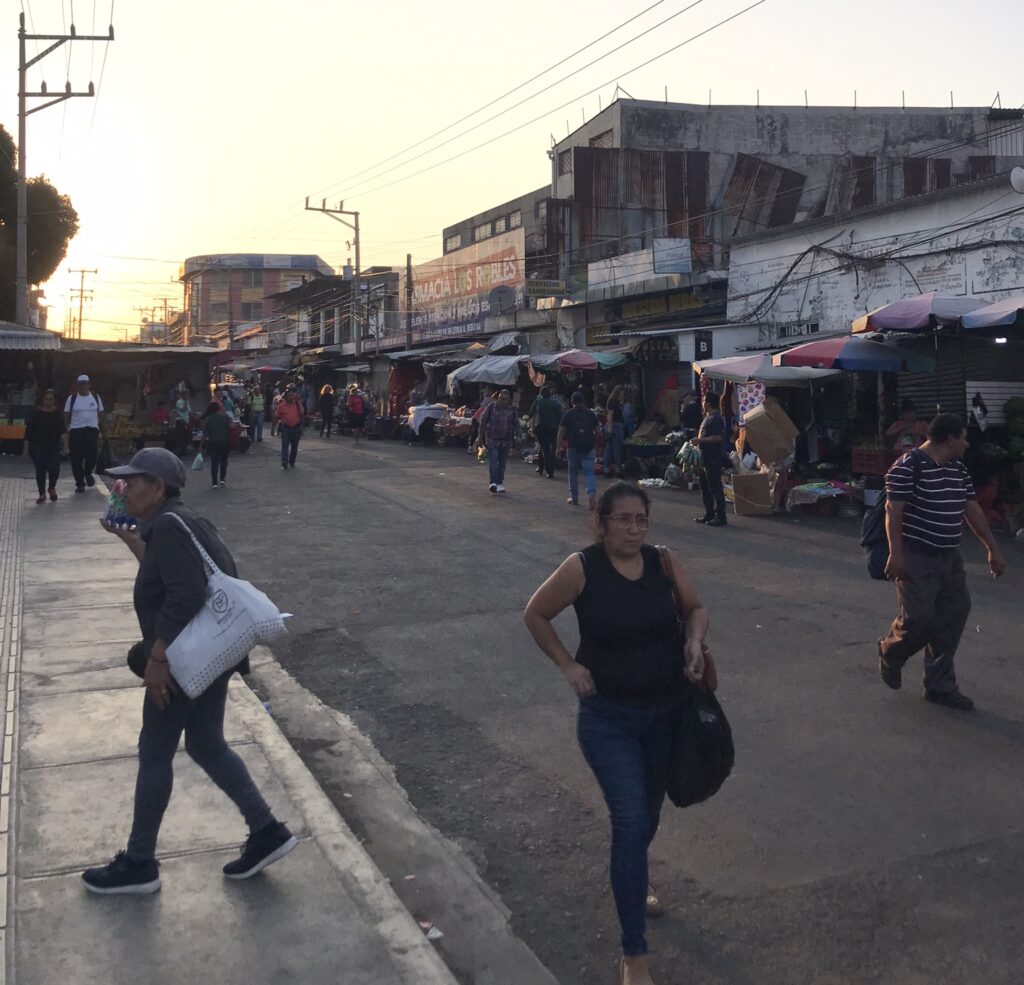
Not much is known about the Salvadoran civil war to outsiders but it had a significant impact on the country, both during the war years themselves and the subsequent decades. The civil war drove many Savadorans to seek refuge in the US. Due to a lack of opportunities, many of the refugees became involved with criminal activity and gangs, especially around the Los Angeles area. Many of these newly-trained gangsters were arrested, and later deported back to El Salvador where they continued with their gang activities. El Savador wasn’t prepared and couldn’t cope with the emergence of these gangs, especially the rival MS13 and Barrio 18 gangs. The gang warfare consumed the country, whole cities and regions came under control of the gangs and lots of young people were forced to join a gang or be killed. Terrified civilians found themselves unable to move to a different area for fear of ending up in a rival gang’s territory, legitimate businesses were extorted and every aspect of the peoples’ lives were dominated by the gangs.
All of this changed with the election of Nayib Bukele as president in 2019. In 2021, Bukele initiated a crackdown on gang activity, arresting thousands of gangsters overnight and building mega-jails to accommodate these mass detentions. As a result, El Salvador went from having one of the highest murder rates in the world to having the lowest in the region. Bukele is seen by the vast majority of locals as the saviour of El Salvador. Gangs are non-existent now and violent crime has dramatically decreased. As of 2024, more than 53,000 suspected gang members have been arrested, the highest reported incarceration rate in the world. Human rights activists have been critical of the mass arrests and accused the regime of carrying out arbitrary detentions and not following the proper judicial process. It has also been alleged that prisoners are being kept in overcrowded and inhumane conditions in the mega-jails. However the overwhelming majority of Salvadorans are in favour of the measures that have been taken. After speaking with numerous Salvadorans, they strongly believe that the actions, while drastic, were justified and have had a transformative impact on their country. Salvadorans can also be sensitive and defensive at times when it comes to overseas criticisms of their government’s actions, feeling that the international community doesn’t have the right to judge these actions as they haven’t lived through the reality of the situation and the violence before the crackdown.

Foreign visitors are still rare in places like Ataco, a town on the Route of Flowers
One interesting quirk of the gang crackdown is that there are virtually no tattooed people in El Salvador. Gangsters were easily identified by their tattoos and we heard that, during the crackdown, tattooed people were detained and interrogated even if their tattoos did not have explicit gang affiliations, just for having tattoos. For Salvadorans, tattoos are intrinsically linked with gangs and a past that they are trying to move away from. If you have prominent tattoos, it’s best to try to cover them up in El Salvador for the time being.
Another consequence of the Salvadoran civil war is the large number of Salvadoran people living abroad. Currently around ⅓ of Salvadorans live in the US and remittances are a big part of the country’s GDP. The American influence is prevalent throughout El Salvador. You can find shops advertising ‘American Clothes’, ‘American Jeans’, ‘American Ice Cream’ and even ‘American Laundry’! We met a guy on the bus who spoke English and told us that he had paid $3000 years ago to enter America as an illegal immigrant – he had later been deported and returned to El Salvador where he was now working as a teacher. Lots of Salvadorans have spent time in the US. We often bumped into a local who was fluent in English or spoke with an American accent. In the small rural town of Ataco we were greeted by a man enthusiastically asking us in English where we were from, as he’d spent some time in America and assumed we were American. In Santa Ana we met a local guy at the market who told us that the thing he missed the most about America was warm showers.
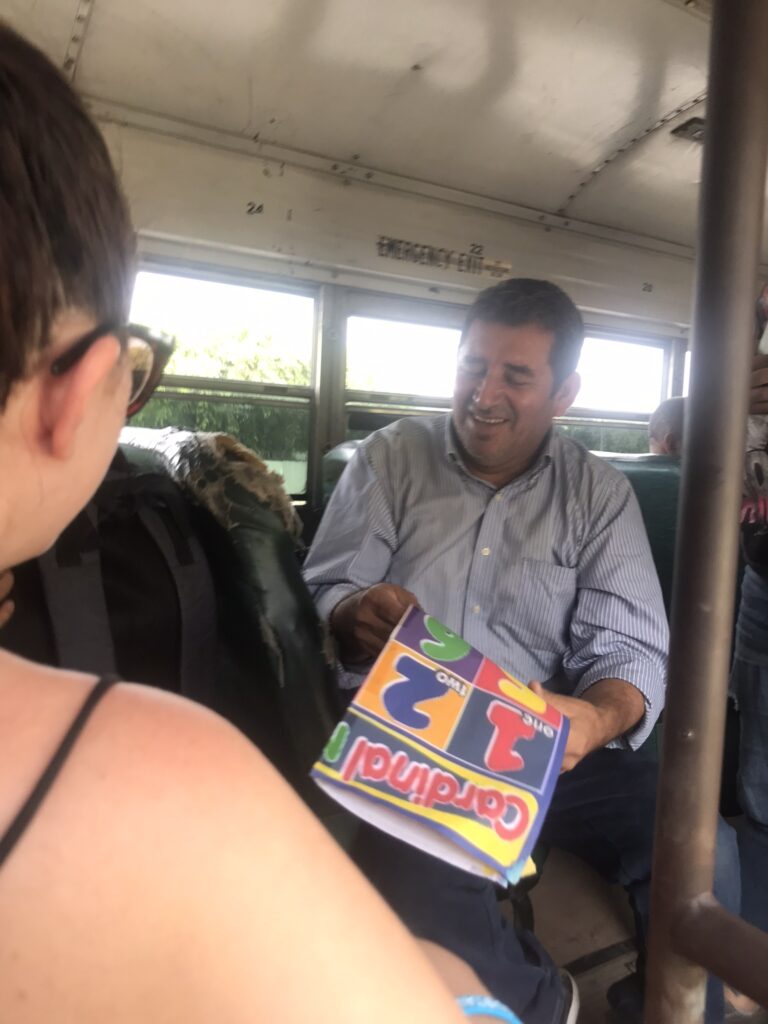
An impromptu English lesson on the chicken bus
Unlike neighbouring countries, El Salvador does not have a visible indigenous population. This is a result of two separate periods of oppression. In the 1930s, the government massacred whole communities of indigenous people following a peasant uprising. This led the remaining indigenous people to suppress their native culture and assimilate in order to avoid becoming a target. During the civil war in the 1980s, indigenous people were again targeted by death squads. As a result, the culture and ethnicity of El Salvador is mostly uniform and homogenous, a typical Spanish-influenced mestizo Catholic society. One notable feature unique to El Salvador is the presence of a portrait of Monsignor Romero in each Catholic church. Monsignor Romero was a Catholic bishop who spoke out against violence committed by US backed government forces and social injustice in the lead up to the civil war and was assassinated during mass in 1980 in San Salvador. This was considered one of the key factors leading to the civil war. Romero was later canonised by the Catholic church and his image is prominently displayed in every church in El Salvador. You will certainly come across Monsignor Romero if you visit any Catholic church in the country.
Strangely, the official currency of El Salvador since 2021 is Bitcoin. This doesn’t make a lot of sense in a cash-dominated society where large sections of the population are employed informally and don’t even have a bank account. While the younger generation have embraced Bitcoin and become crypto enthusiasts, many older people in the country struggle to keep up. We were really interested to see Bitcoin-ATMs where people were able to access their money and make transactions. Bitcoin use in El Salvador is expanding, it can be used to make medium-sized and large purchases, however don’t expect to use Bitcoin to pay for the bus. The reality is that it is not completely pervasive in society. We didn’t pay for anything with Bitcoin in El Salvador. The everyday currency is US dollars and that is what most of the people use in their daily lives.
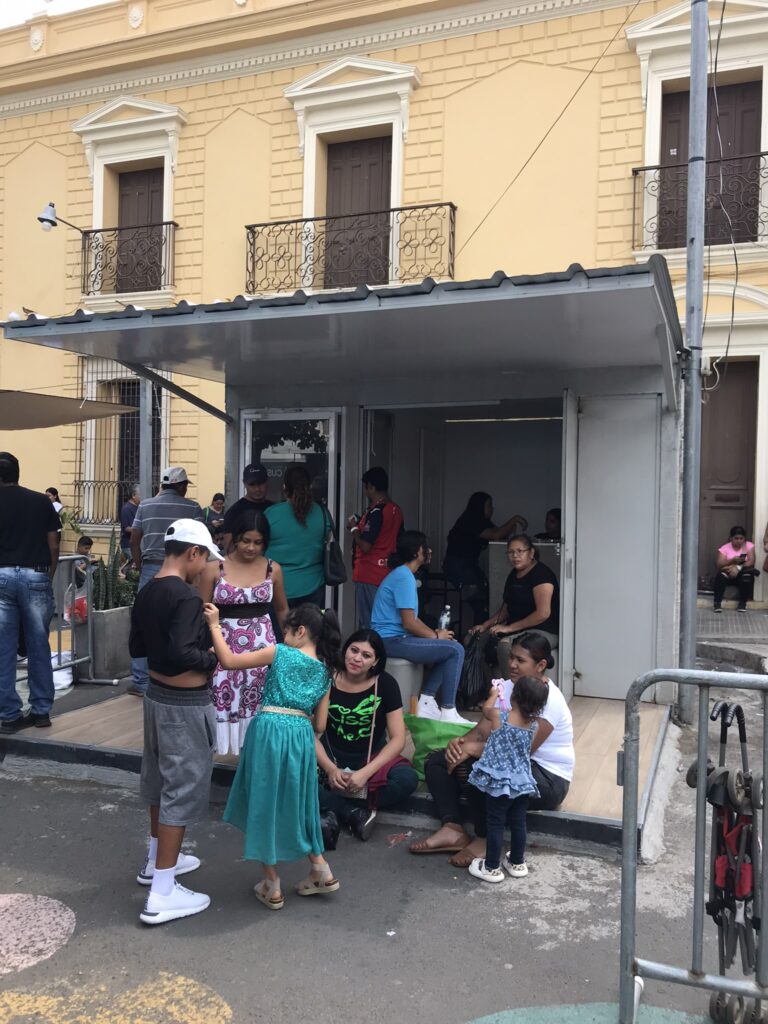
The queue outside a Bitcoin ATM in Santa Ana
One of the things that Salvadorans abroad miss the most about El Salvador is pupusas. These grilled pockets made with corn or rice flour containing tasty fillings are the national dish of El Salvador. An unpretentious finger-food which is often served with a spicy tomato salsa, be prepared to get messy while scoffing your pupusa! In Pupuserias or on street corners you can often spot matronly women by the grill, happily preparing pupusas for hungry customers passing by. Pupusas are a cheap street food snack and a great option for budget travelers.
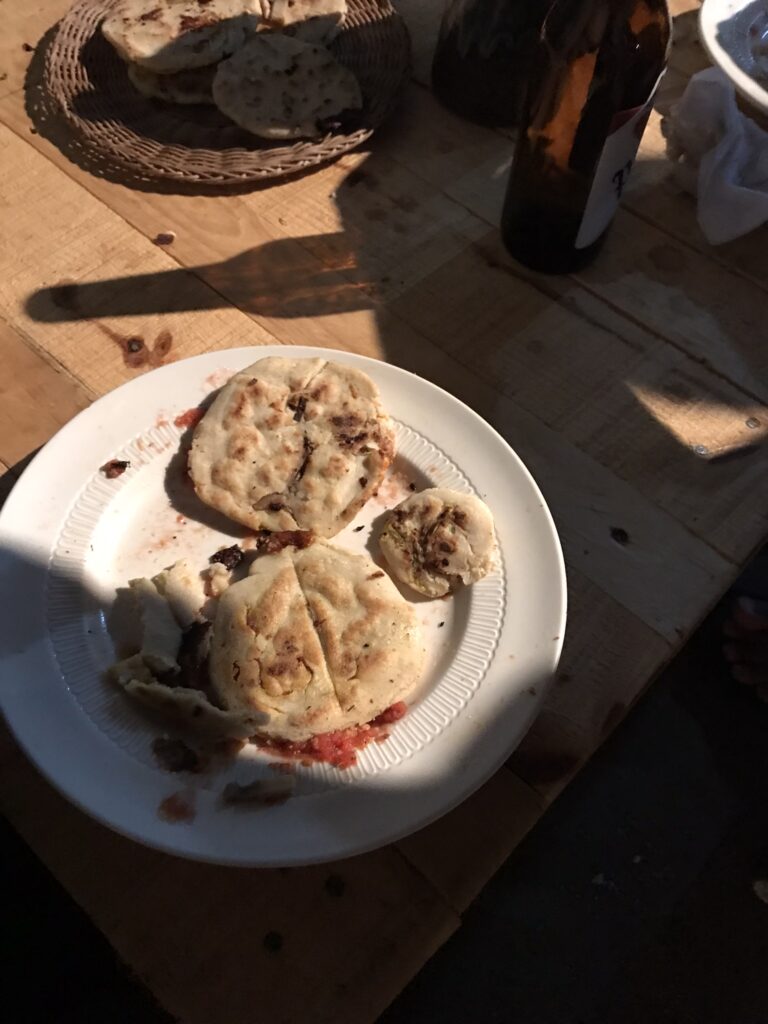
Feasting on home-made pupusas in Santa Ana
Santa Ana
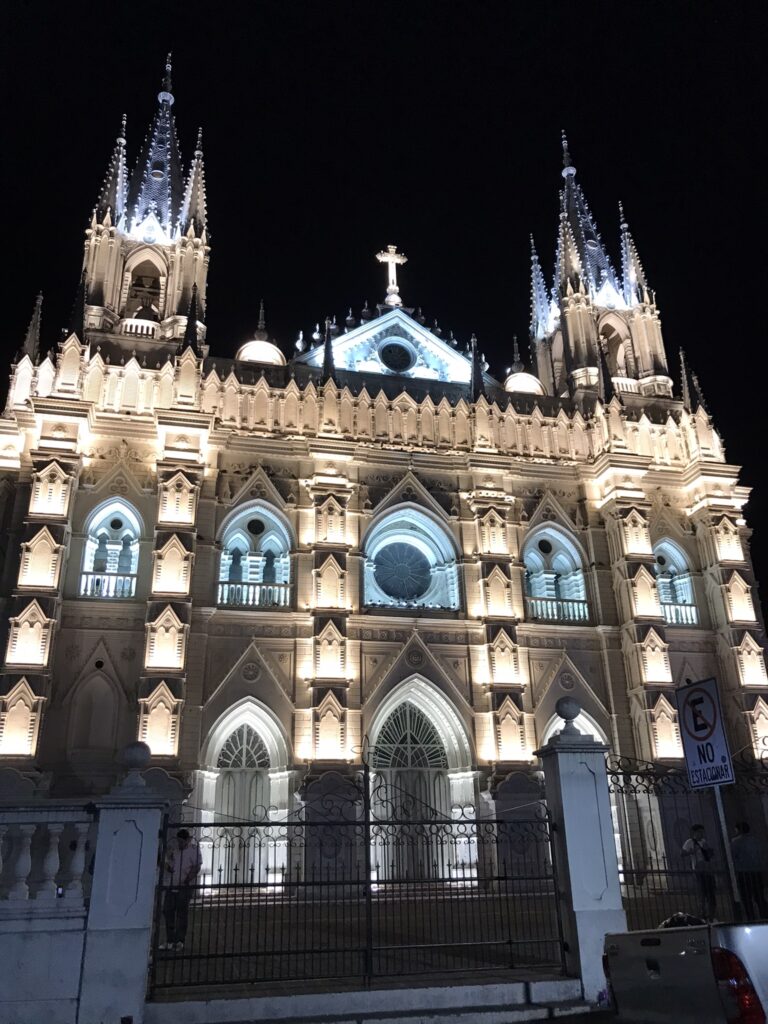
Santa Ana is the second largest city in El Salvador and the closest major city to the Guatemalan border. Parque Libertad is the beating heart of the city’s colonial centre, with the imposing Santa Ana Cathedral dominating the city skyline. Outside of the main square, however, the reality of the city becomes very different. Santa Ana is a mostly unattractive city. There are several large market areas where local farmers and merchants sell their wares – we found that the market areas were often deserted by late afternoon and gave off a distinctly spooky vibe after the hustle and bustle of the busy morning trade.
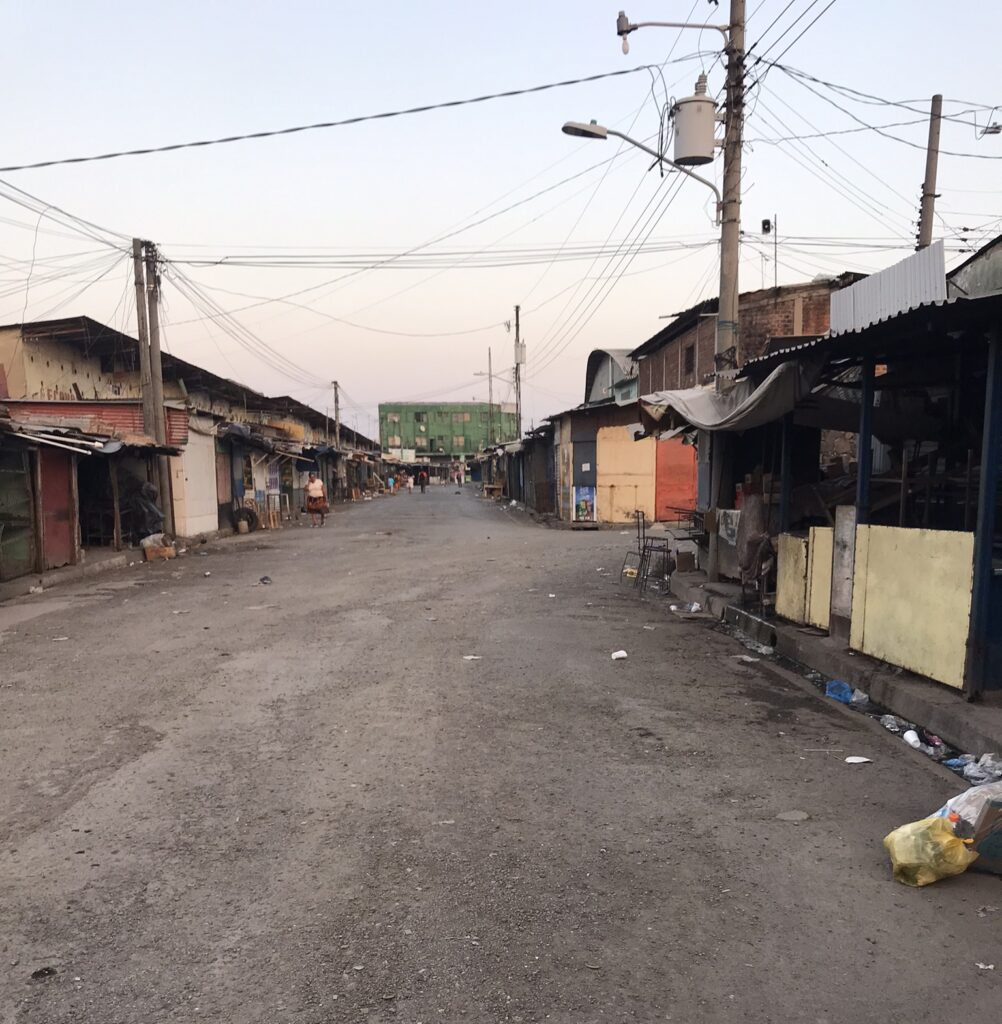
The market area isn’t a great place to be after it closes
Parque Libertad is a popular meeting place, with families and groups of friends often congregating to share a Little Ceasar’s Pizza or grab a ‘panes’ hot dog. We found that there was a joyful, jubilant atmosphere in Parque Libertad. Locals seemed happy just to be able to walk freely outside and enjoy their lives free from the oppression of gangsters. You might even be lucky and catch a free concert in Parque Libertad. If not, there are regular performances at the National Theatre, which is located in the square and is considered a focal point for culture in El Salvador. Tickets are affordable to ensure that both locals and visitors are able to enjoy the performances.
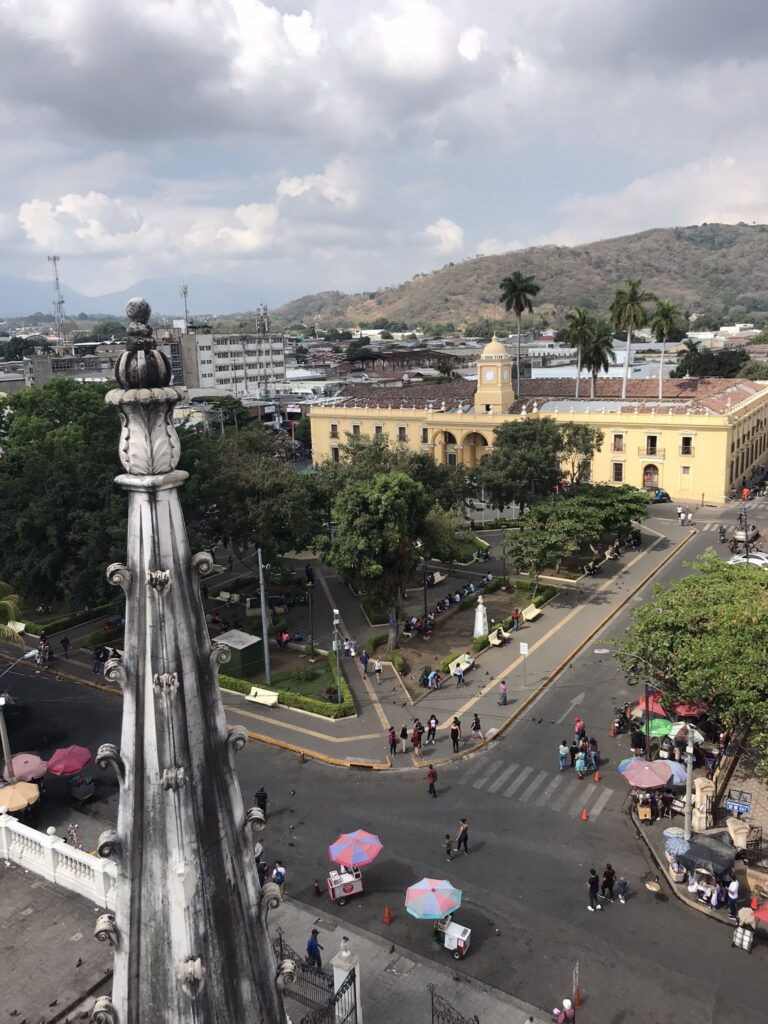
Parque Libertad from the roof of the Cathedral
Our first impression of Santa Ana wasn’t great. When we first arrived, we walked through a sketchy area with many drunk, homeless-looking people. We were later told that this was one of the areas that was most affected by the gang violence. While El Salvador has solved its gang problem, it is clear that there are still social issues and poverty facing many people in the country, which is still visible in the cities.
Accommodation
Casa Central de Santa Ana – this place was in a great location, only a couple of minutes walk from the main square at Parque Libertad. We found that the rooms were comfortable and affordable, the shared kitchen was a bonus and the proprietor let us use the laundry facilities for a fair price.
Foodie Places
Artisant – an excellent American-style burger house. We loved the burgers here, surprisingly it was very quiet when we visited.
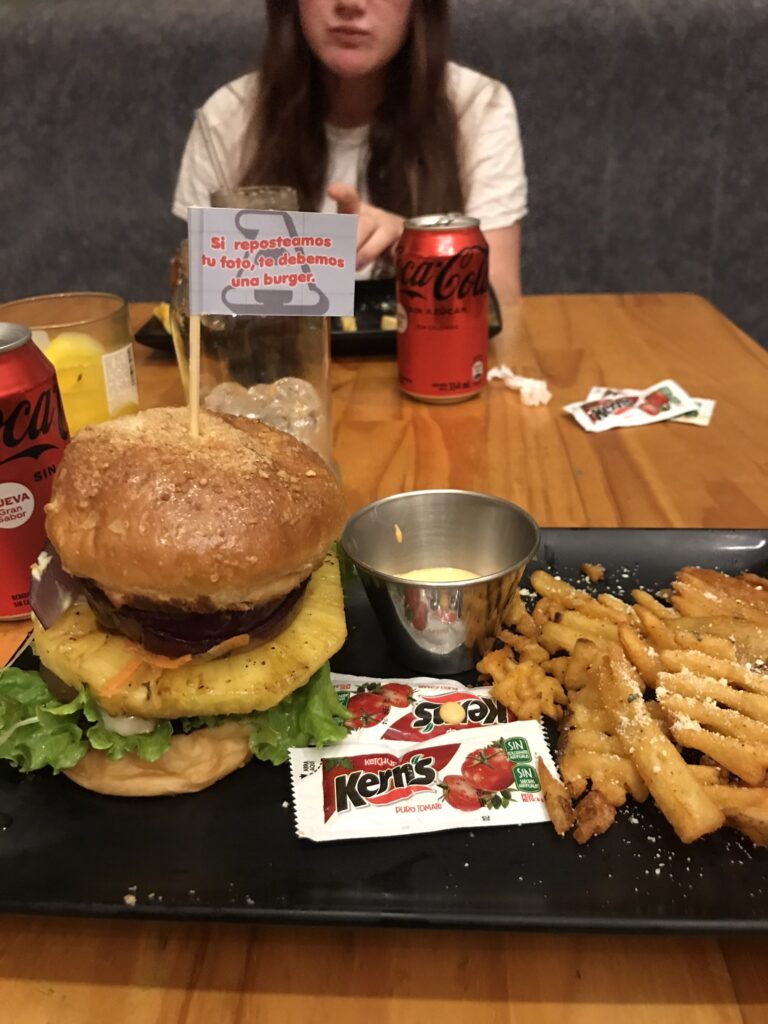
For the best burgers in Santa Ana look no further than Artisant
Super Selectos • Santa Ana – due to having a kitchen in our accommodation we opted to cook most of our meals in Santa Ana, which meant many visits to Super Selectos. While the range of products on offer was good (we really liked the rotisserie-style chicken), this was one of the worst supermarket experiences due to the long queues and extreme disorganisation at the checkout. Allow a lot of time if you want to get anything from here.
Panes Titi – we were recommended this street food stand in the main square, which was one of several kiosks in the area selling the same product. This was a cheap and basic hotdog-style snack made with bread, sauce and either soya or real meat. Ironically, the non-meat soya option is called ‘carne’ at these stalls (meaning meat), this can lead to a lot of confusion and distrust for vegetarians and vegans. It is an open secret that the carne option is actually soya but the locals historically don’t want to acknowledge that it is not real meat. Trust me, it really is soya!
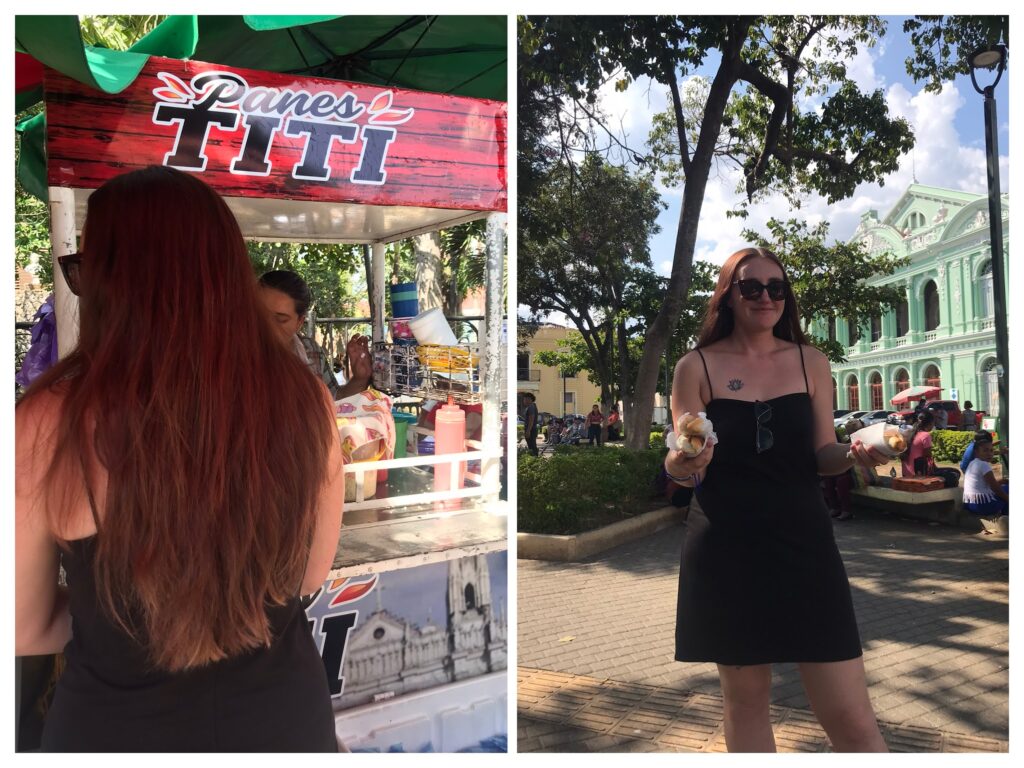
3 ‘panes’ hotdogs for a $1 – not bad!
Activities
Guruwalk walking tour with Hector – we loved this Guruwalk, it is one of the best free walking tours we have ever taken. Hector is a very engaging young local guy who grew up amongst the gang violence and learned English while working in a call centre. As well as delving into the history of the city, we also had a market visit involving fruit tasting, local horchata (milk-based drink claimed by various Central American countries), a type of beef salad and other local products. The best part of the tour was after it had finished, Hector invited us to a coffee shop where we were able to ask him any and all questions about El Salvador, his life and personal experiences. Controversial questions were welcomed and encouraged! This was a fascinating insight into the real experiences of a person who had first-hand experience of local life both during and after the era of the gangs. The coffee shop itself was really nice too!

Some of the fruit on the walking tour was super sour!
Pupusa-making class at Pupuseria La Tiendita with Yolanda. We arranged this with Hector during our walking tour. The class cost $10, pupusas and a bottle of beer included. As a group we made the pupusas together from scratch, mixing the dough, preparing the fillings and finally assembling our own pupusas using different combinations of the various ingredients. Vegetarians and vegans need to take care to make sure their pupusas don’t get mixed in with the rest. We were encouraged to mark our pupusas before they were grilled, however this didn’t always work so well and we found that it was often difficult to find your own pupusa. We ended up eating a selection of random pupusas! Some were more tasty than others.

Getting hands on at the pupusa cooking class in Santa Ana
Rooftop of the Cathedral – we visited as part of the Guruwalk, however it is possible to head to the Cathedral rooftop on your own steam for an up-close look at the iconic white steeples as well as great views over Parque Libertad, the city and surrounding areas.
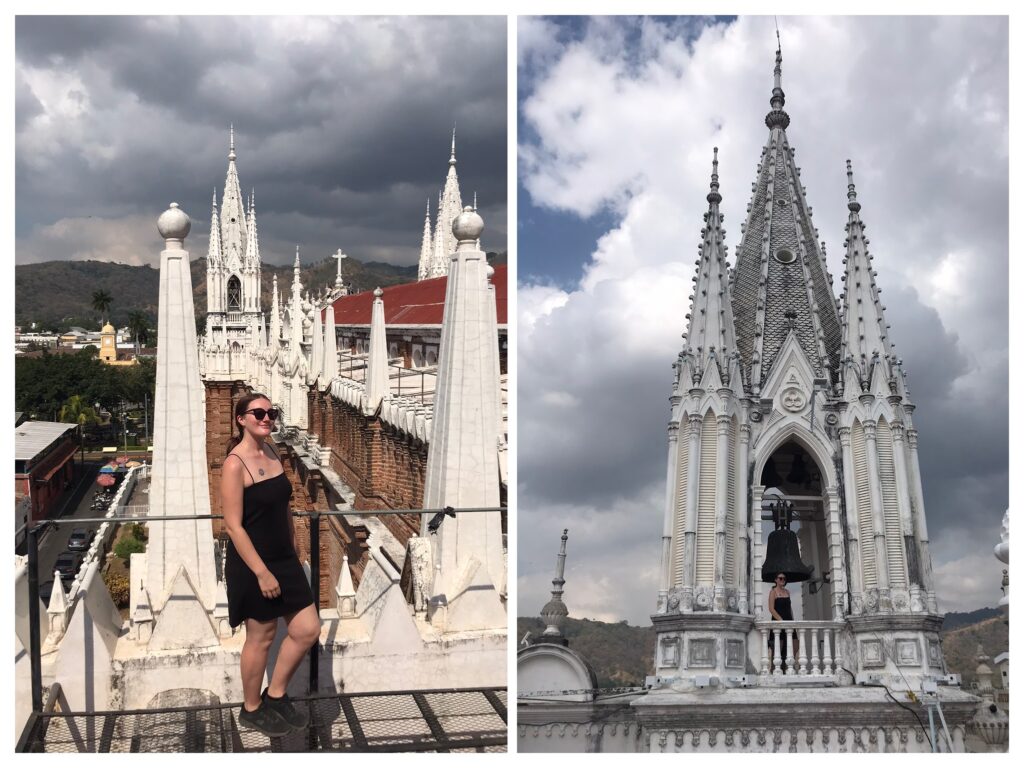
The Cathedral rooftop provides a great backdrop for photos
A popular activity for many travelers is to visit the Santa Ana volcano and gaze at the spectacular lake inside the crater. We chose not to do this as we were all volcanoed-out after Guatemala. If you choose to visit the volcano, make sure to be prepared – we met some girls at our accommodation who had made the journey to see the volcano, only to find that it was closed and they had to turn back.
Ruta de las flores – this is a collection of towns located south of Santa Ana between Ahuachapan and Sonsonate. This area is known for the beautiful flowers along the road in the springtime, giving it the name Ruta de las Flores or Route of Flowers. There are several popular towns along the route, without a car it would be difficult to visit them all in a single day however we were able to make it to Ataco, Juayua and back to Santa Ana in a day by bus. We took the 210 bus from Santa Ana to Ahuachapan, and then the 249 bus running along the Ruta de las Flores itself, and finally the 238 bus from Juayua back to Santa Ana from the bus stop here.
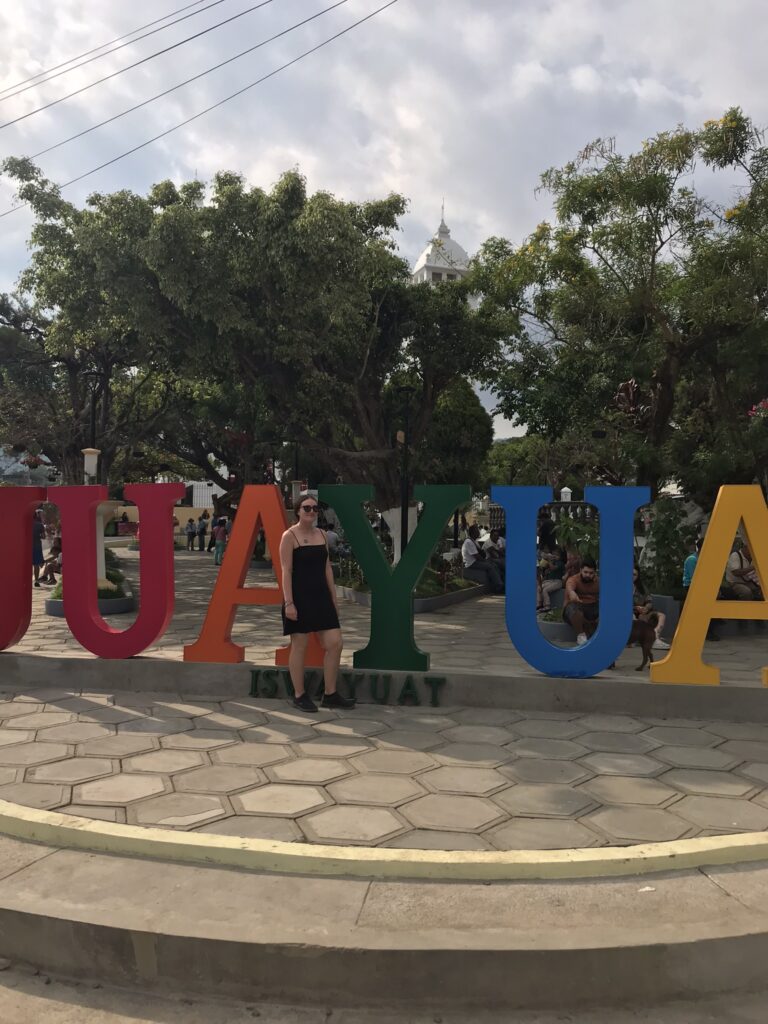
Juayua is a popular stop on the Route of Flowers
Ataco – in Ataco we headed straight to the El Carmen Estate for horse-riding and a coffee tour. El Carmen is a large coffee producer and exporter in the region. English and Spanish tours are available, although we took the tour in Spanish as we were pressed for time and didn’t want to wait around for the English guide. On the coffee tour we were shown hessian sacks with writing in different languages and scripts which were used for exporting coffee to a myriad of countries around the world, including Japan and Arab states. The horse riding was a brief 30 minute jaunt around the estate and landscapes surrounding the farm. If, like me, you can’t resist the urge to jump on a horse, the riding at El Carmen was an affordable way to explore the farm.
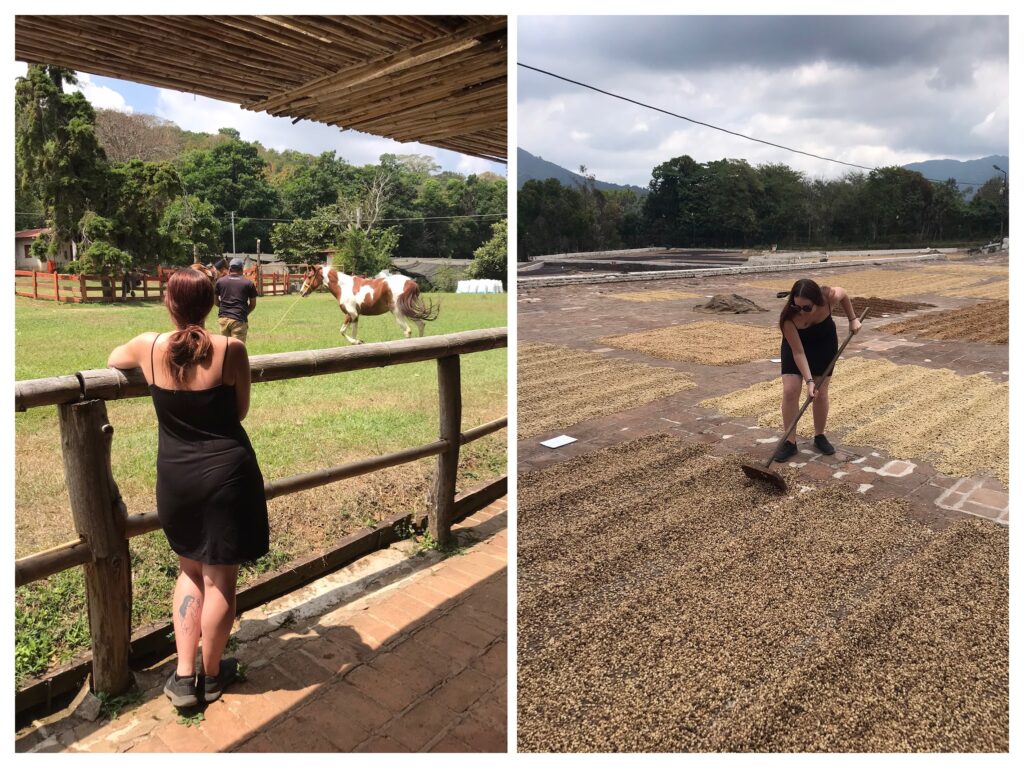
Getting put to work on the coffee farm (El Carmen Estate in Ataco)
Mirador de la Cruz – we walked to the mirador from the centre of Ataco, past the Iglesia El Calvario. The mirador provided a unique aerial perspective of the town and surrounding countryside.
Juayua – this town is renowned for its weekend food festival, but we were unlucky to visit on the one weekend that the festival wasn’t actually taking place due to local elections. Juayua is a typical small colonial town and one of the largest settlements on the Route of Flowers. It is also known as the starting point of the seven waterfalls hike, which is popular with tourists and locals. Again, we didn’t do this hike due to time constraints. Because the food festival was not taking place we had to have a sit-down meal, and after that we only really had enough time to wander the streets of the town and have a look in the large colonial church before heading back.
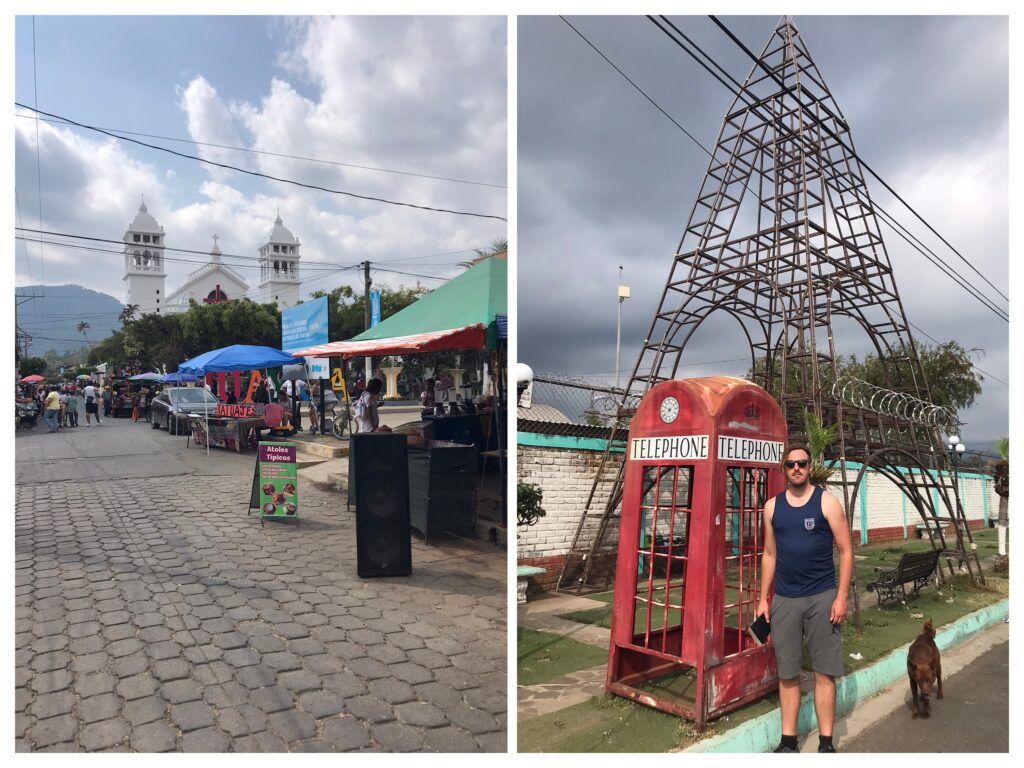
Finding curiosities in the backstreets of Juayua
Suchitoto
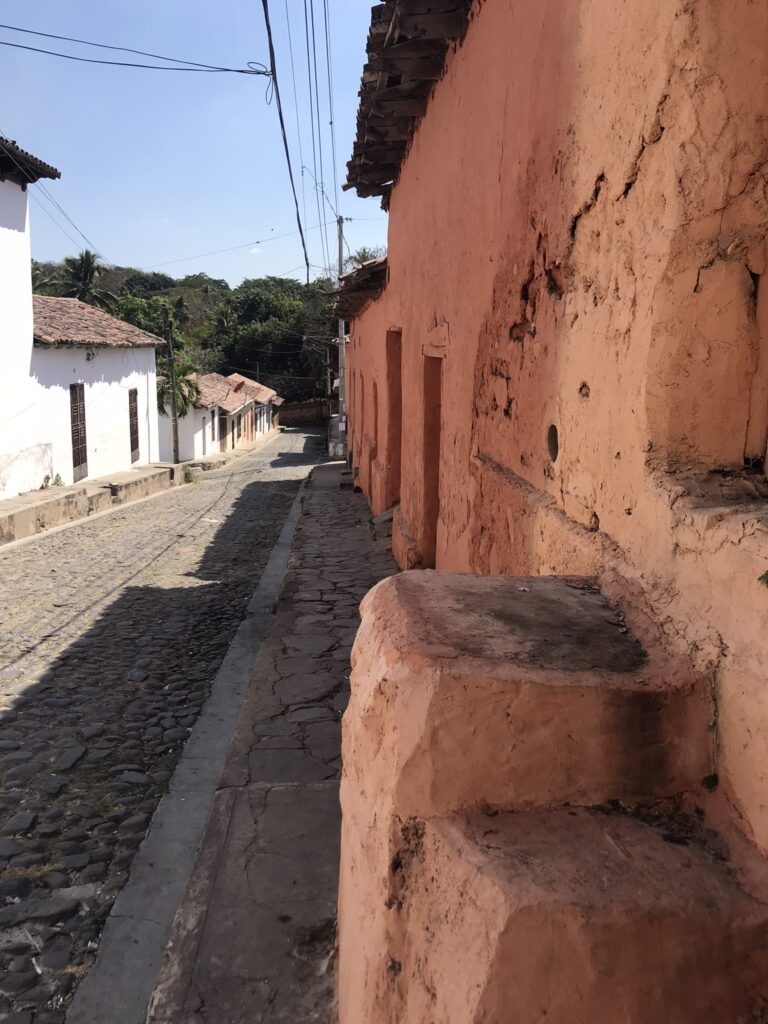
Amidst a maze of cobblestone roads sits Suchitoto, a colonial jewel which overlooks the mighty Suchitlán Lake. Public life is centred around the central park, where locals will often be seen sipping beer at alfresco restaurants which line the outside of the plaza. The pristine white Catholic church is the main focal point in the square, a visible reminder of the importance of religion in the daily life of most locals. It’s important to note that most restaurants close their doors on a Monday, taking a well-earned break after the hectic weekend. We found that the town was very laid-back and sedate with residents nattering away on their doorsteps and going about their daily routine as normal – although this slow pace may be because we visited early in the week rather than at the weekend.
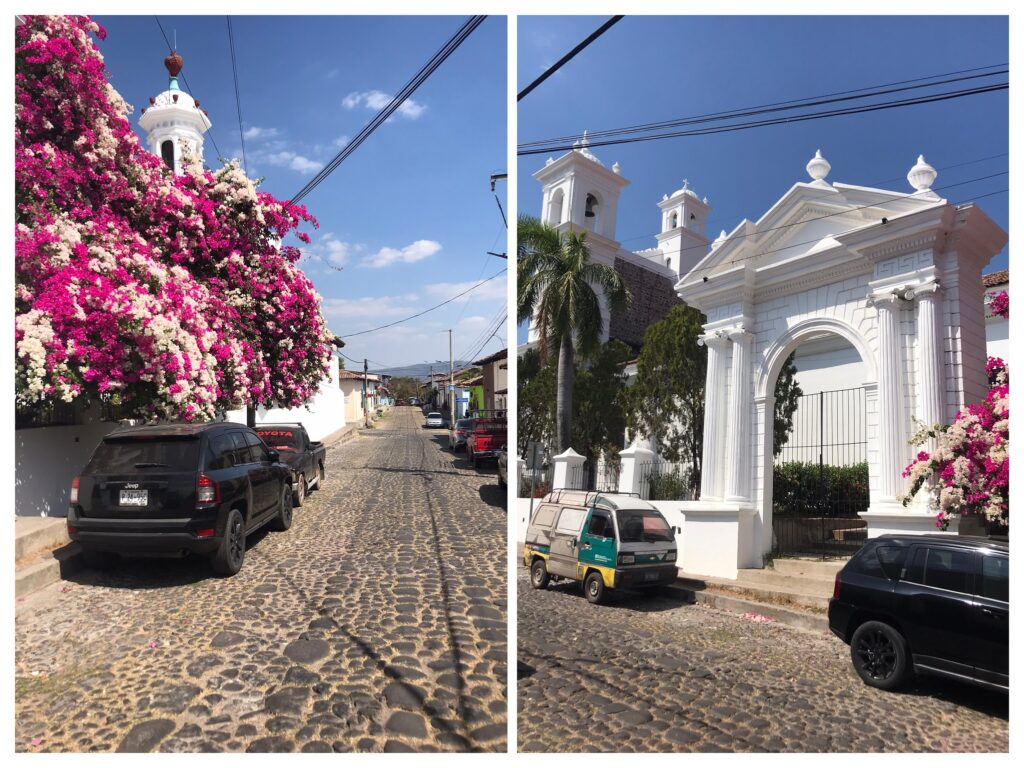
Exploring the streets of Suchitoto, a great way to spend the morning or afternoon
Despite its laid-back nature, Suchitoto was a stronghold for resistance during the Salvadoran civil war and was an epicentre of guerrilla action. Guerilla groups took refuge on the nearby Guazapa hill, with fighting spilling out throughout the surrounding region. Very little information is readily available about the guerilla and military action that took place in and around Suchitoto, it is hard to find much info even in the town itself. The Peace Arts Centre contains an intriguing map which shows the various battle sites, massacres and mass graves, however much of the guerilla action in Suchitoto seems to be unwritten history, or perhaps history that was erased by the side that came out victorious in the conflict. Previously tours were available which explored some of the battle sites and landmarks of the conflict, however we don’t think these are currently running.
We met several people who had visited Suchitoto via bus from San Salvador, however when coming from Santa Ana this would involve getting from one bus station to another on opposite sides of San Salvador, crossing the busy and sprawling city either by foot (2 hours walk minimum) or by trying to find a taxi (which we hate). It is possible to head to Suchitoto from Santa Ana via chicken bus without transiting through San Salvador. Take the 276 bus from Santa Ana to Apopa, after being dropped off by the chicken bus you have to cross the bridge across the highway and then wait here (co-ordinates 13.795292451534053, -89.17730352442207) for any bus heading north to Aguilares. In Aguilares, you can take the 163 bus to Suchitoto from here (co-ordinates 13.958845381992706, -89.185459). A kind family helped us to find the correct bus stop at Aguilares. This journey took us about four hours and we had plenty of memorable encounters with local people on the chicken buses along the way, including an impromptu English lesson with some schoolboys who were cajoled into it by a grinning Salvadoran teacher!
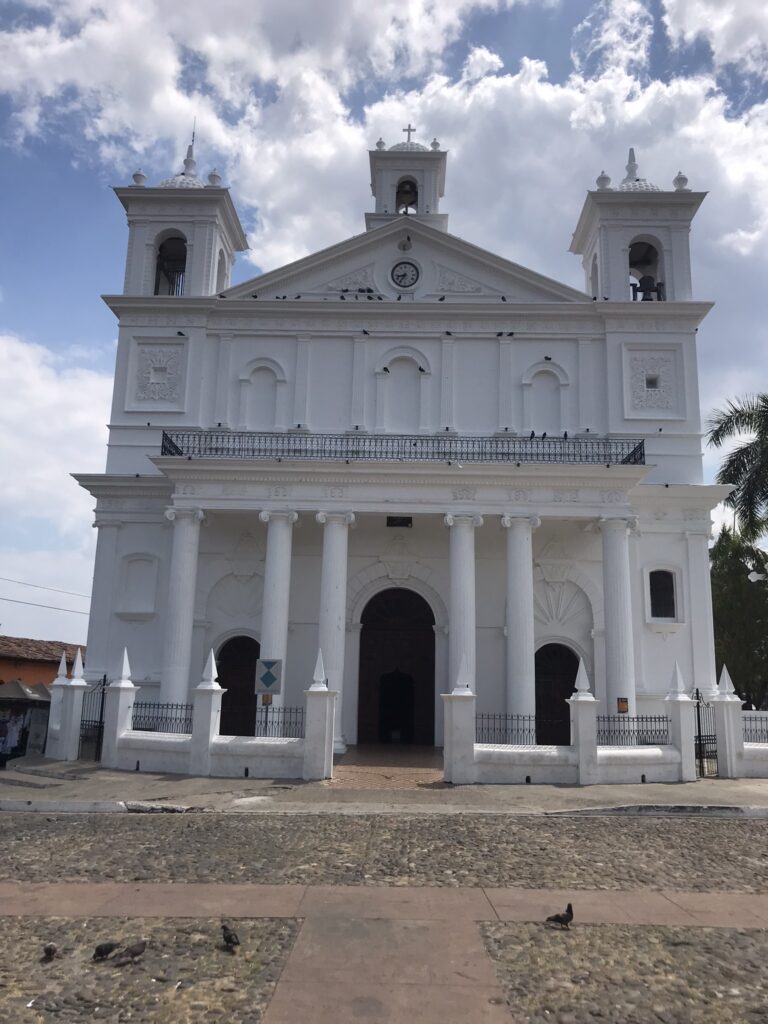
The brilliant white church in Suchitoto: Parroquia de Santa Lucía
Accommodation
Hostal Koltin Suchitoto – a pleasant hotel in a colonial-style residence. All the rooms are situated around a central courtyard and include access to a shared kitchen, there are also hammocks to laze around in and a cool rooftop area to watch the sunset. This place had more of a hotel vibe than a hostel and this was reflected in the clientele, however we did encounter some interesting scousers (English people from Liverpool) in the hostel. All I’ll say is that the last time we saw them they were drinking tinnies (beer) in the main square with their feet in the fountain, this was at 10am! Suchitoto is not exactly a party town so I’m not sure what they were doing there.

Watching the sunset at Koltin Hostal
Foodie Places
La Lupita del Portal – one of the only places open on a Monday evening, situated in prime position in the main square. Restaurants surrounding a town’s main square can often be a bit of a tourist trap, however in this case the price was affordable and the quality was pretty good too.
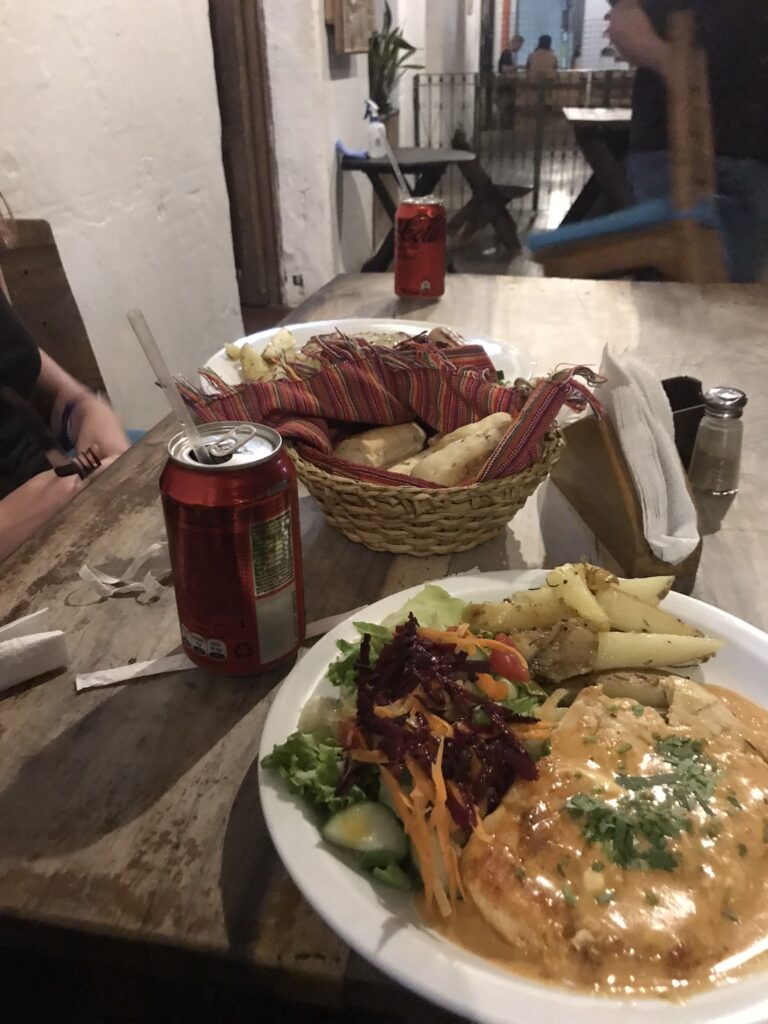
La Lupita del Portal didn’t disappoint!
Ixcanal café – we had a disappointing club sandwich here, which seemed to be missing most of the ingredients of a typical club sandwich. In fact the only ingredients seemed to be cheese and ham. The servers were friendly though and we did appreciate the air conditioning which was a much-needed respite from midday heat.
La Neveria – a popular Salvadoran ice cream chain, specialising in delicious frozen yoghurt and other treats. We indulged in some refreshing mango smoothies and they didn’t disappoint. La Neveria in Suchitoto is not on Google Maps, but you can find it in the main square next to the cathedral.
Activities
Peace Arts Center – the Peace Arts Center has a small exhibit which spotlights elements of the armed guerilla struggle from the perspective of locals who were directly affected. Nuggets of insight are still present only in local oral history which is recorded here. The centre also contains artwork for sale from aspiring artists and local youngsters, as well as a community centre.
Mirador de Suchitoto – the best place in town for views over Lake Suchitlán, this mirador also has a roof to provide shelter from the sun. This is a quiet and peaceful viewpoint, you probably won’t have to elbow people out of the way for the best view here. There is a steep descent down some cobblestone roads (and a steep ascent back up afterwards).
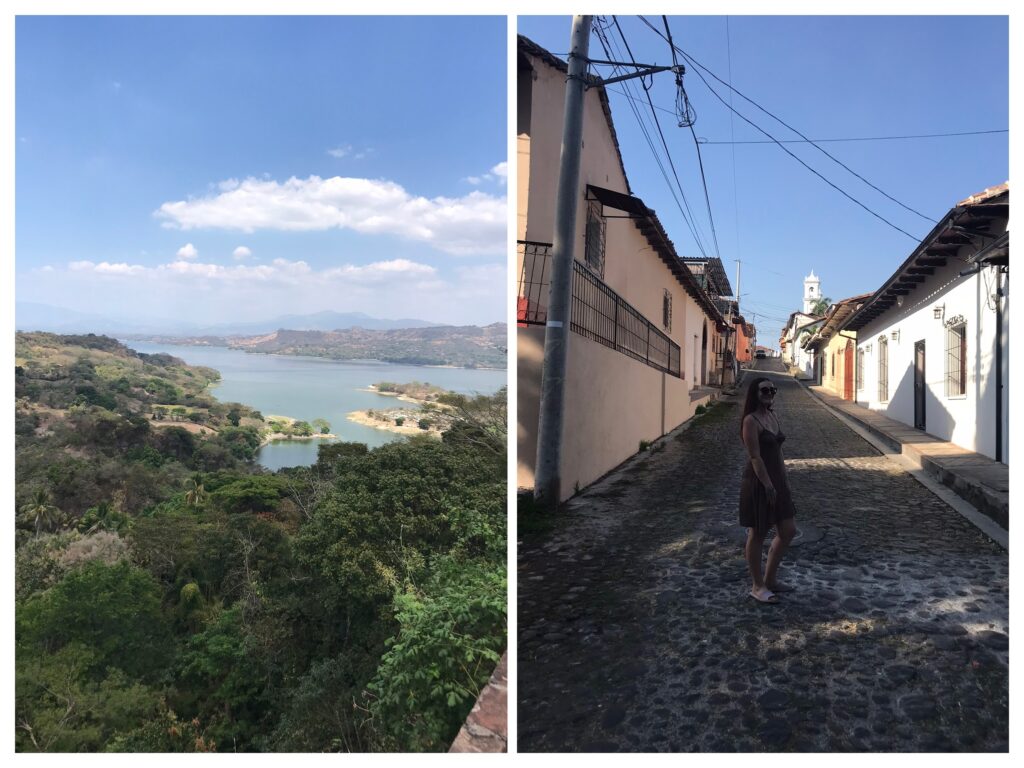
The view at Mirador Suchitoto is worth the uphill trek back into town
Cascada Los Tercios – located around 30 minutes walk out of town. A small admission fee is required to gain entry to the waterfall trail, this was collected by an unofficial-looking guy at the entrance. Along the way to the petrified waterfall is a stunning viewpoint of the lake and a couple of scenic rest stops with ample seating. For the best views of the petrified waterfall you have to climb to the bottom of the dried riverbed, be prepared for a bit of scrambling on the rocks to make it down. I believe the waterfall runs during the rainy season, obscuring the rock formation. It was dry when we visited.
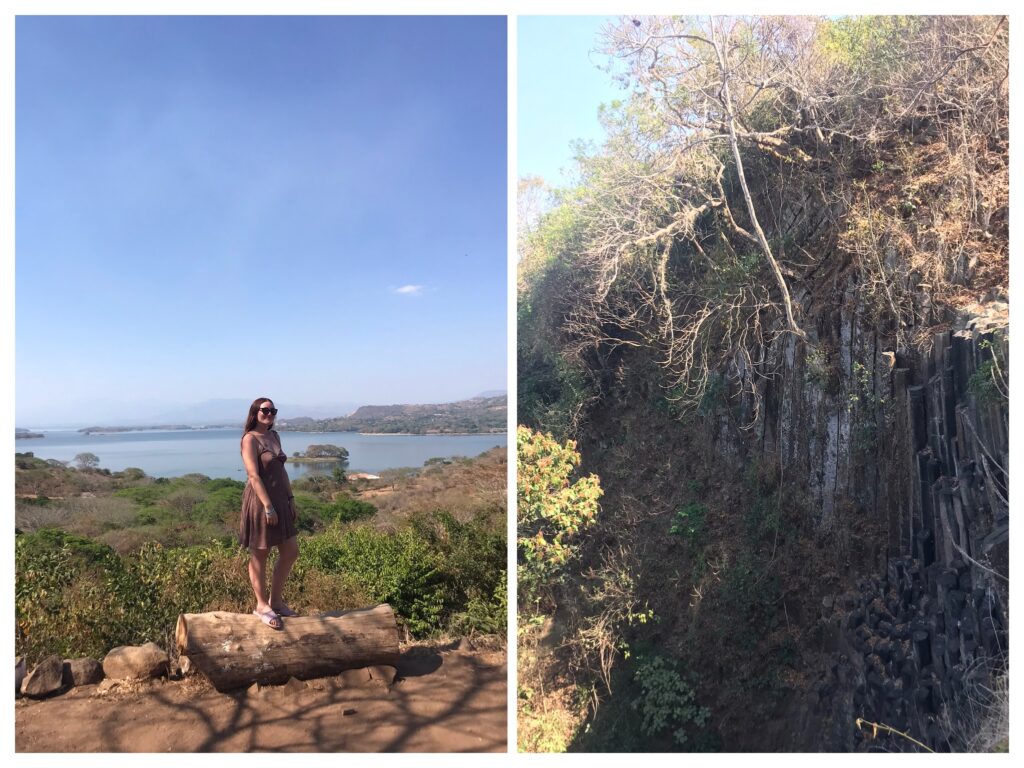
After the sweaty walk from the town we didn’t bother climbing to the bottom of the petrified waterfall. We later realised that this was a mistake!
San Salvador

Like the rest of El Salvador, San Salvador is still finding its feet in many ways after being freed from the gang violence that previously overwhelmed the country. While San Salvador has plenty of malls and modern shopping centres, informal economy still dominates large swathes of the city. We saw numerous areas with vast, sprawling street markets and were told that these sort of market areas used to engulf an even bigger portion of the city. Recently President Bukele has launched a scheme to modernise and regulate these shanty areas and move market sellers to official premises.
San Salvador boasts modern concrete tower blocks as well as grand monumental buildings around the historic centre such as the Metropolitan Cathedral and the National Palace, the opulent former home of the Salvadoran parliament. We were intrigued by the Church of the Rosary, a futuristic church which looks more like something from a sci-fi movie. The ultra-modern National Library is a new addition to the historical district, this building was funded by China and has state-of-the-art facilities including a gaming room. After watching a promotional video featuring the inside of the National Library we were very impressed. We were told kids have to read a book before they are then allowed to use a games console. These modern buildings are a stark contrast to the ramshackle nature of some of the market areas of town.
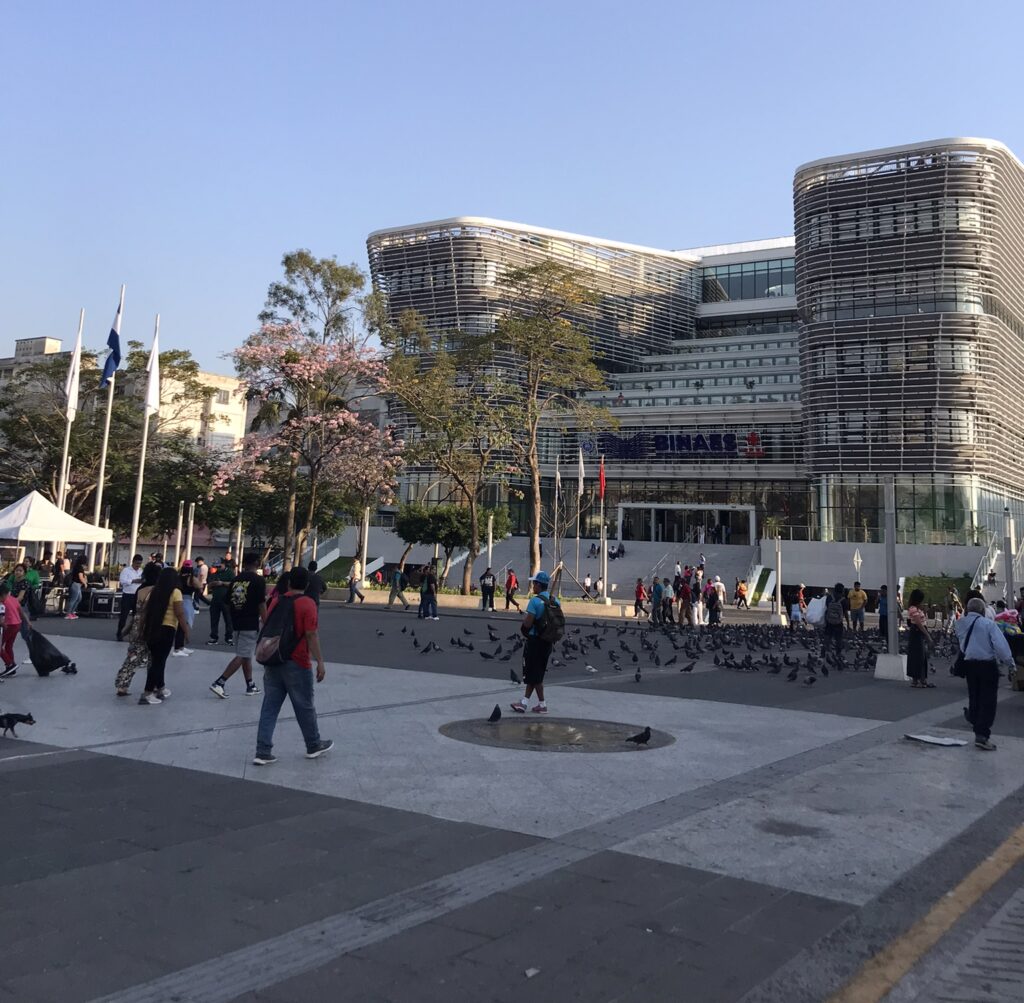
The brand-new National Library is very popular amongst young people
Like many places in Central America, San Salvador is a city of contradictions. Parts of central San Salvador shared the same joyful energy as the Parque Libertad in Santa Ana, such as Liberty Plaza where we saw pop-up cumbia bands competing for attention and people dancing to the music in the street. Other poorer parts of the city did not seem to be so jubilant. While the gangsters are no longer a threat, it is clear that life is still difficult for many of the residents of San Salvador. This disparity was present in the exclusive San Benito neighbourhood, home to many rich and famous Salvadorans, where impeccably dressed men and women drove around in their expensive cars away from the plight of the less fortunate.
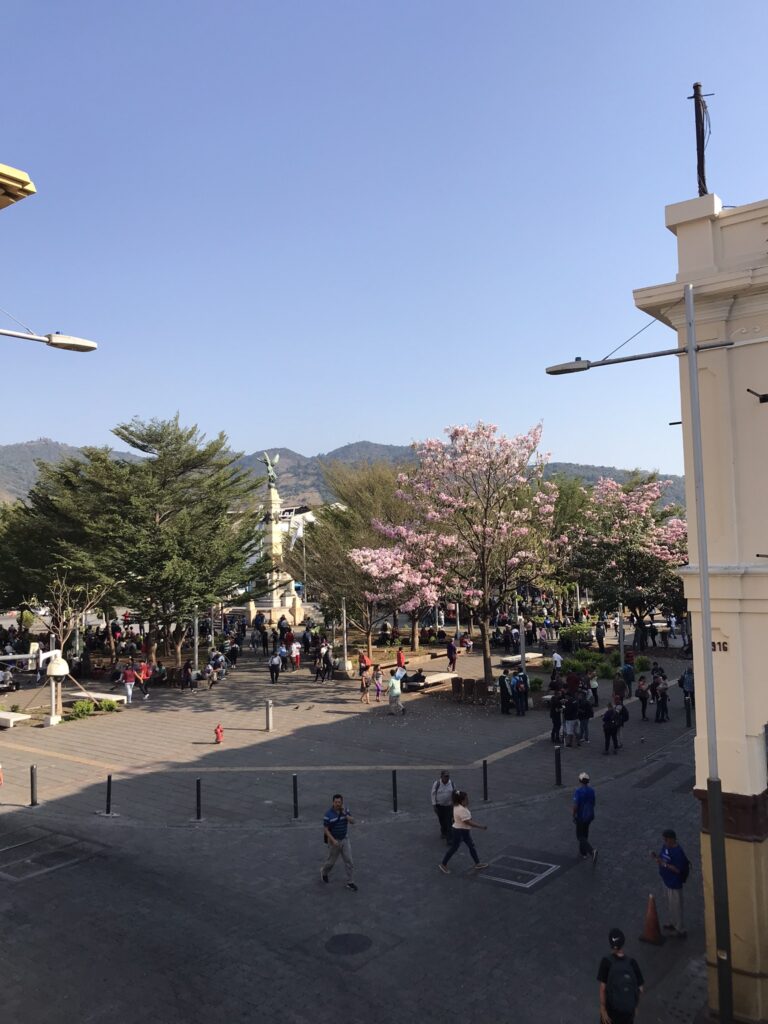
Liberty Plaza is the outdoor music hub of the city with live bands performing in the square. It’s normal to find locals dancing to the music!
Accommodation
Hostal de Asturias – located in the Centroamerica district which was a little far out of the city centre, although there were plenty of restaurants and amenities in the area. This was definitely not a hostel, it was a large hotel catering mostly to business clientele. We found the rooms to be comfortable and enjoyed the included Salvadoran breakfast. We spotted quite a few businessmen at breakfast including one American guy who claimed he worked for the Salvadoran embassy in the US.
Foodie Places
Sushi Bites – a very enjoyable sushi takeaway and restaurant. We got 50 pieces of sushi with 4 beers for around £40, and the sushi was really good (I’m a bit of a sushi snob).
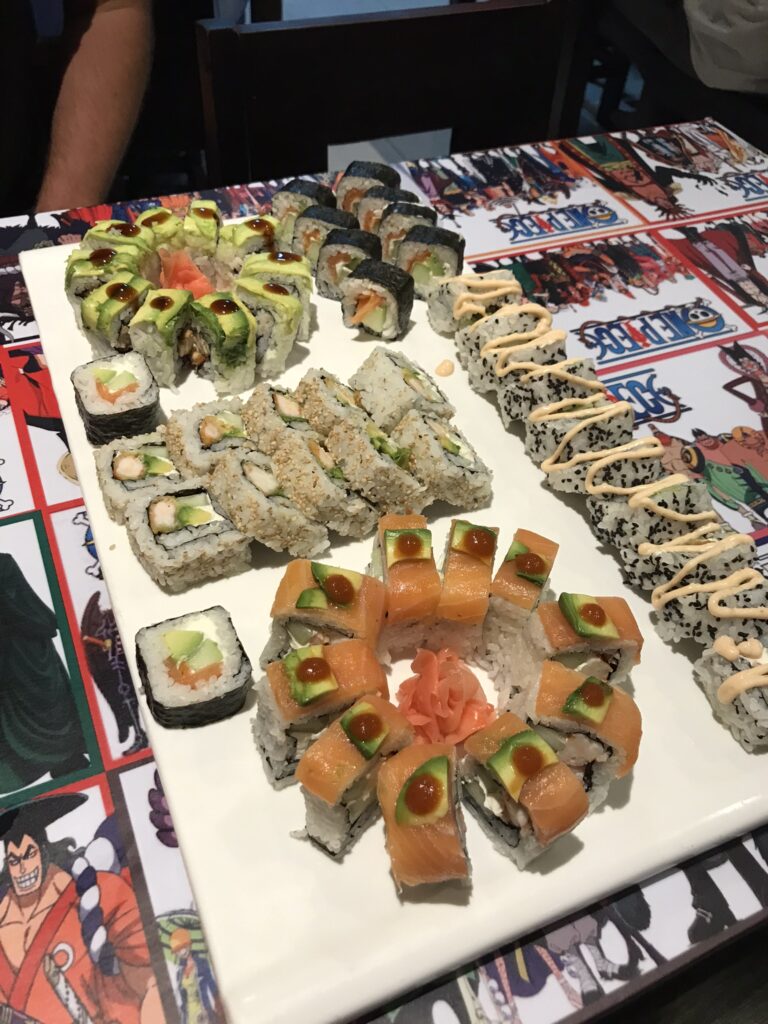
When it comes to ordering sushi, my policy is always go big or go home!
Pupusería Gabriela – a local establishment near our hotel serving, you guessed it, pupusas. This was a real unpretentious place which was packed with locals of all ages and walks of life. We stood out a mile as the only gringos, and got plenty of curious and inquisitive looks while enjoying our pupusas.
Pupuseria Galicia – we had these pupusas delivered to our hotel on Uber eats. We actually preferred the pupusas here to those served in Gabriela, we also enjoyed the extra-chocolatey hot chocolate.
LUMA Panadería Experimental – close to Museo de Arte and the president’s house. A real upmarket and trendy establishment with prices to match. Most of the customers were young, wealthy socialite types. The artisanal sourdough bread is made on site, the baker can be seen tossing the dough around in the back of the shop.
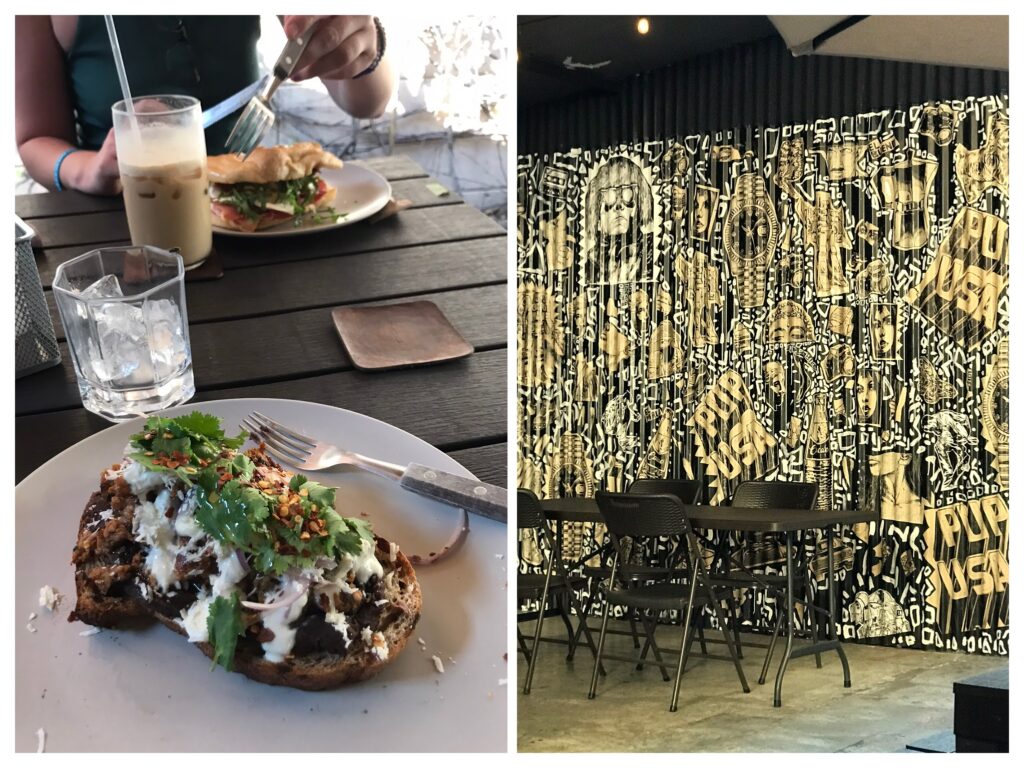
A dainty lunch at LUMA
Pollo Campero – we were thrilled that our favourite Guatemalan chicken shop was also in El Salvador!
Activities
Guruwalk with stops including the Metropolitan Cathedral of San Salvador, the grandiose National Palace, Church of the Rosary with its rainbow stained glass windows, Cha cha chá (a Cuban themed bar with cool views over Liberty Plaza), a market area that used to be completely covered with market stalls and Liberty Plaza.
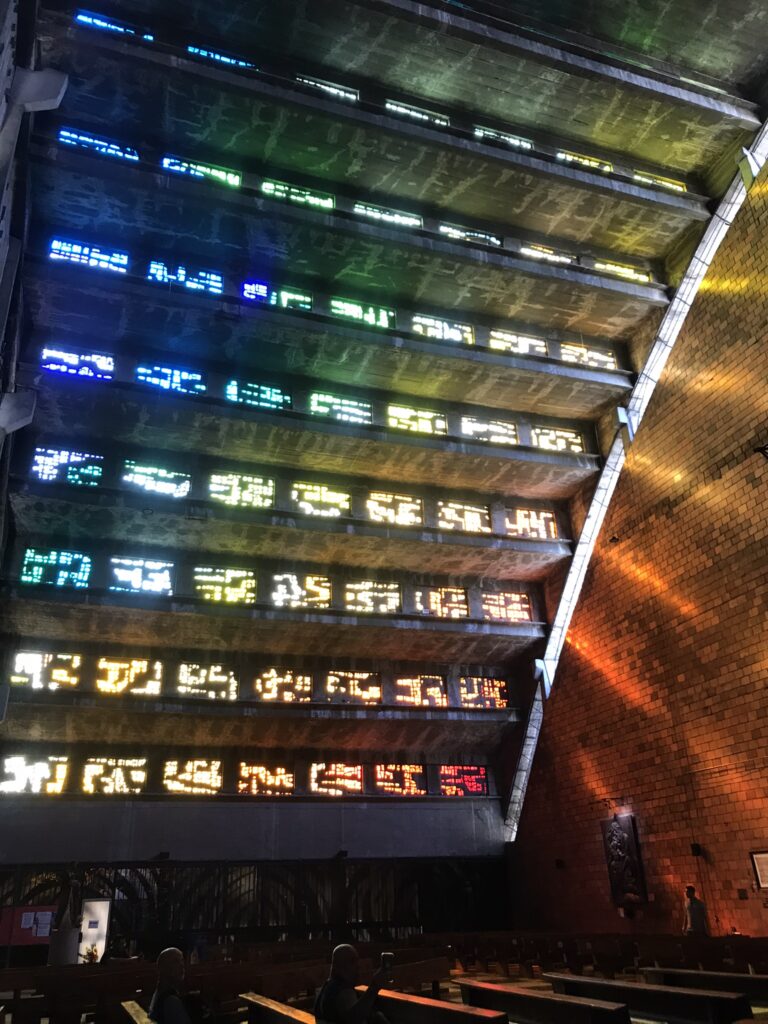
Rainbow stained-glass façade at Church of the Rosary
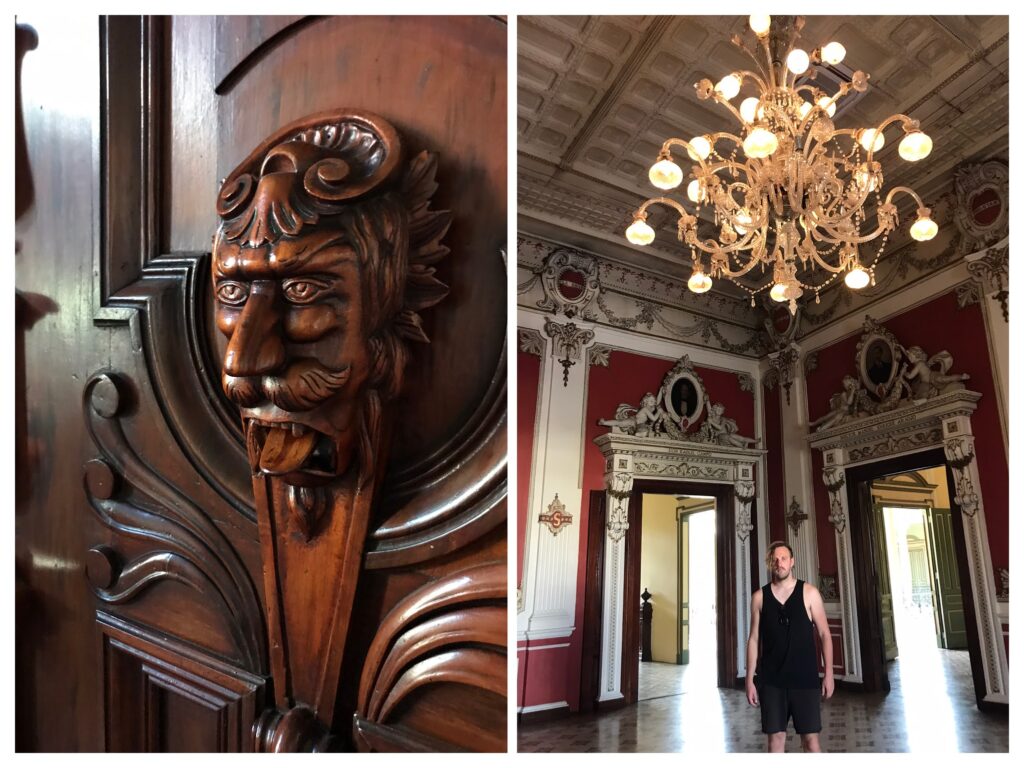
Snooping around the National Palace in San Salvador
Monument to the Divine Saviour of the World – we walked here from our accommodation. This is a small park with a large monumental sculpture located in the centre of a busy road intersection, and is considered an iconic symbol of San Salvador.
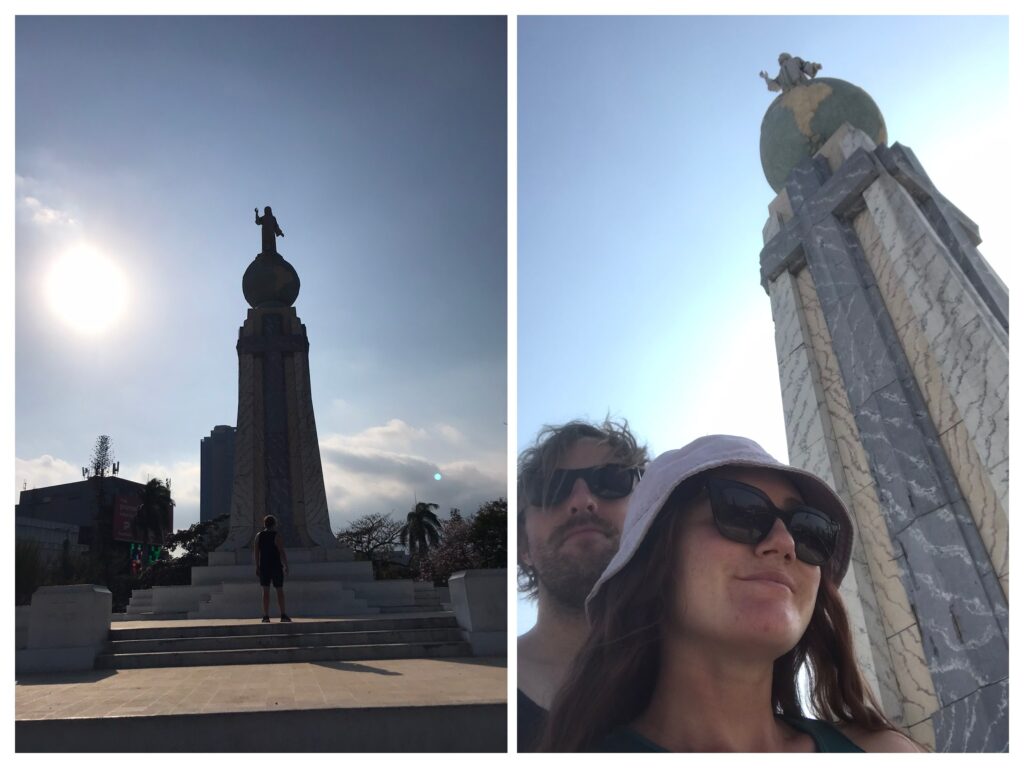
Divine Saviour of the World monument in San Salvador
Museo de Arte – this gallery contained mostly Salvadoran modern art, with an effort in recent years to spotlight national artists rather than those from overseas. This gallery had a fantastic array of themes, from folklore and pastoral works to art reflecting the history and development of El Salvador. The art relating to the recent violence in the country was particularly salient. We also liked speaking with the very engaging art students/gallery guides – I spoke to one guide for about an hour and didn’t realise that the gallery was about to close!
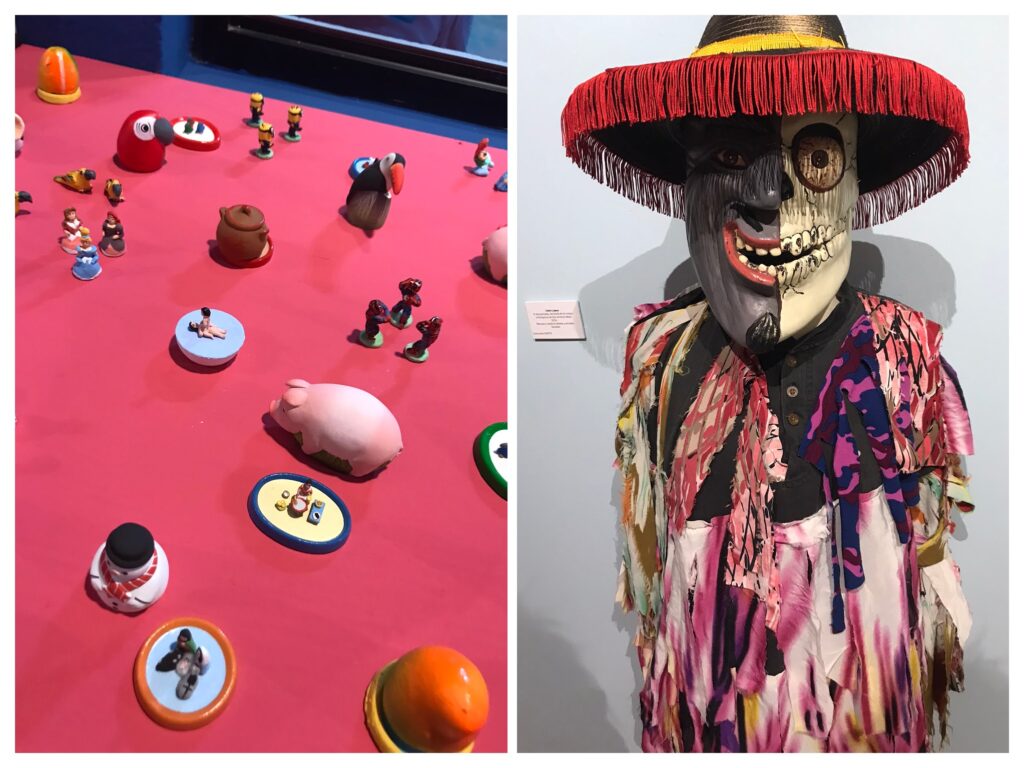
Museo de Arte is a fantastic art gallery in the San Benito neighbourhood
Metrocentro San Salvador – going to the mall is a huge deal in many Central American countries, and El Salvador is no exception. This American-style shopping mall was crammed full of retail outlets and food places.
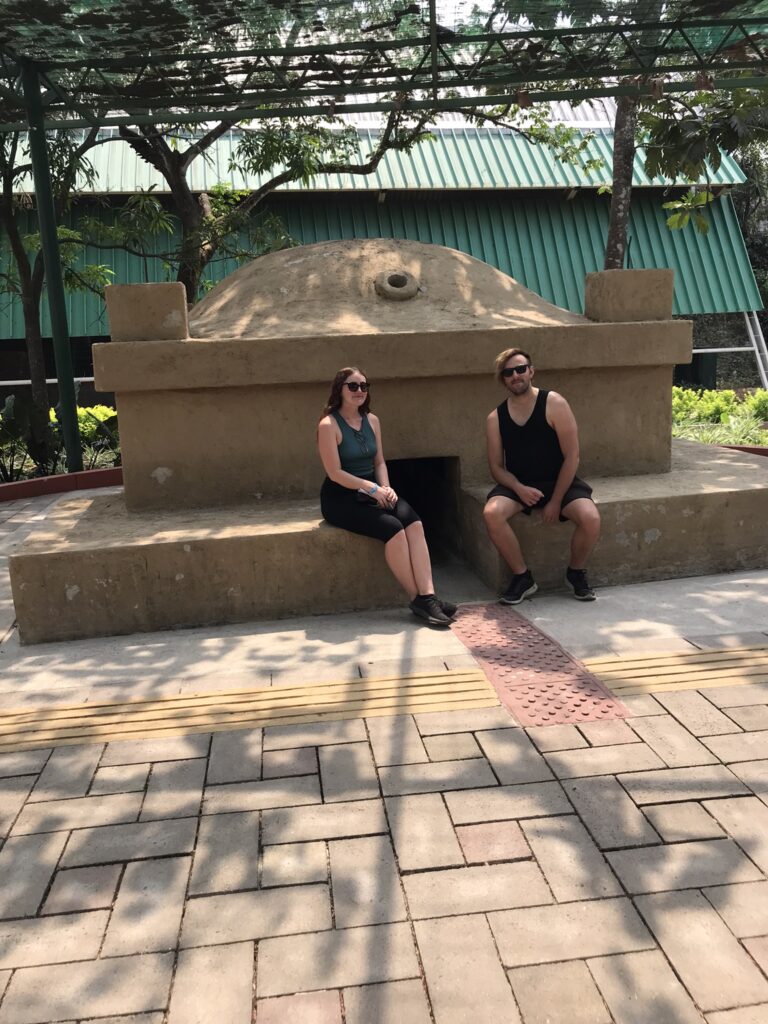
The temazcal at Joya de Ceren
Joya de Ceren – Described as the ‘Pompeii of the Americas’, Joya de Ceren is a unique archaeological site situated between San Salvador and Santa Ana. It’s ideal to visit on a day trip and easy to get there from San Salvador using the 108 bus, which departs from here and passes right by the entrance to Joya de Ceren. The site is notable because it contains the remains of a Mayan village which was destroyed and preserved following a volcanic eruption. It is El Salvador’s only UNESCO World Heritage site and the only place to see the remnants of a small, everyday Mayan village, as opposed to a grand ceremonial centre like most of the major Mayan sites. While it is not the most spectacular set of ruins you’ll encounter in Central America, the historical value of this site is immense. In our opinion Joya de Ceren is an underrated and underappreciated archaeological site. There is also a museum onsite with some Mayan artefacts on display. It’s well worth the effort to pay a visit.
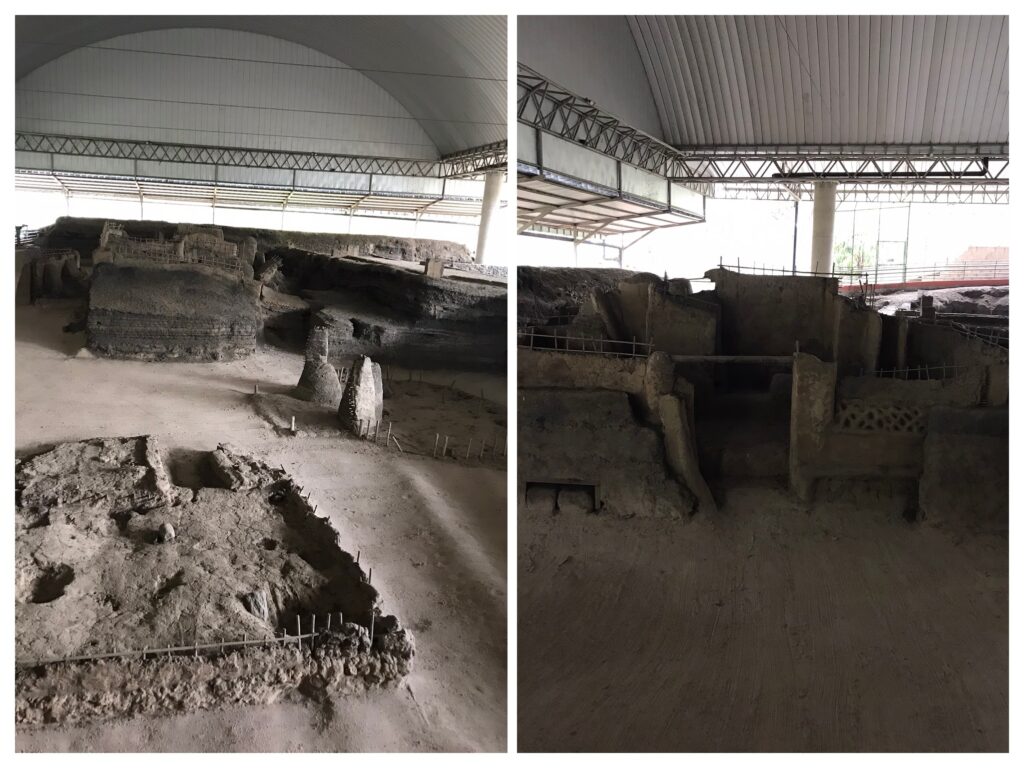
Petrified lower-class Mayan houses at Joya de Ceren
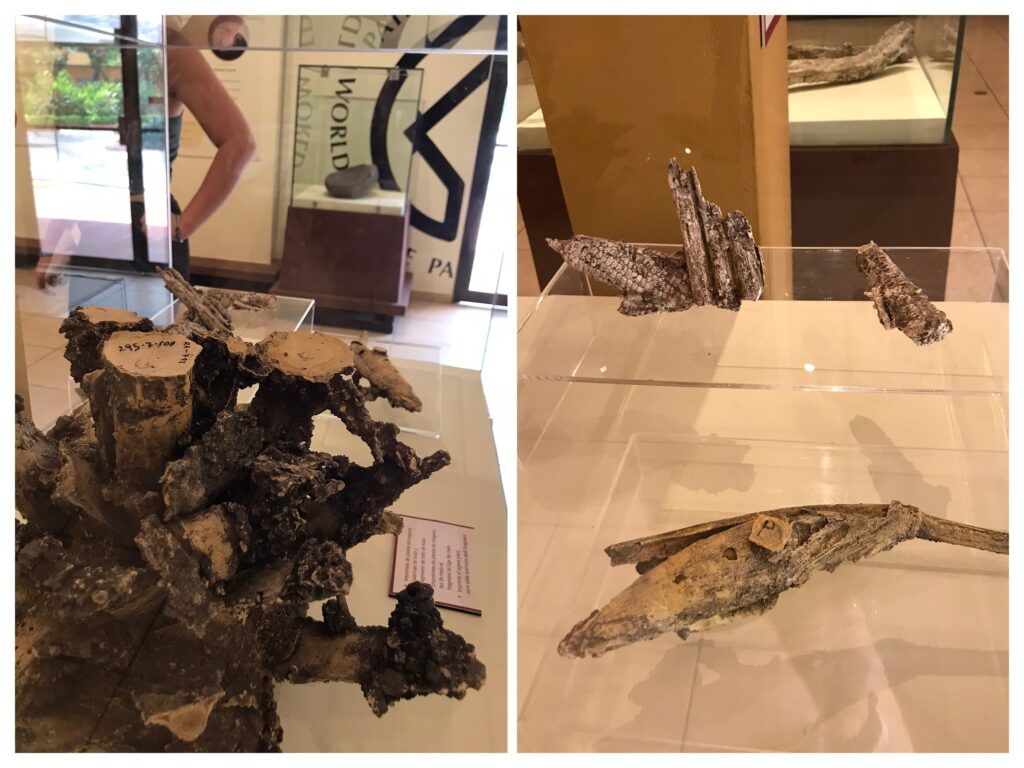
In the museum at Joya de Ceren you can find some preserved corn husks and agave on display
After visiting El Salvador, we headed to Honduras! Click here to read about my experience crossing from San Salvador to Copan Ruinas via El Poy.
